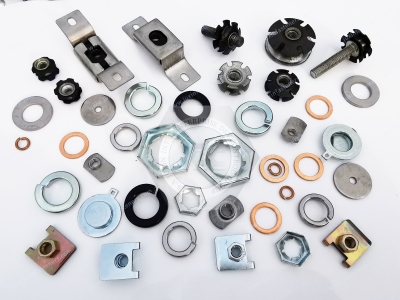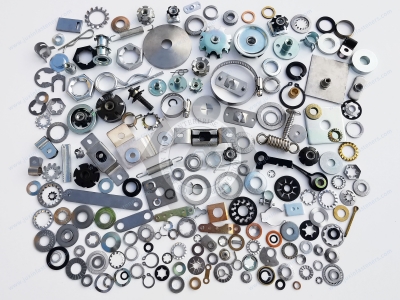Call Us
+86 136 6007 9809
Call Us
+86 136 6007 9809
Oct. 15, 2023
Open-end retaining rings are E-shaped retaining rings used for fixing parts on shafts and are suitable for open-end single rings with nominal diameters of D=1.2~15mm. A stainless steel retaining ring has the properties of a stainless steel material, but E-type open retaining ring stainless steel is better. Stainless steel resistant to air, steam, water, and other weak corrosive media or stainless steel is called stainless steel and will be resistant to chemical media corrosion (acid, alkali, salt, and other chemical impregnation) of steel is called acid-resistant steel. Because the two's chemical composition differences make the corrosion resistance different, ordinary stainless steel is generally not resistant to corrosion in chemical media, while acid-resistant steel is usually stainless.
E-type open retaining ring removal industry solutions
A hand-held flat screwdriver inserts the flat into the hole on the side of the relevant part. Twist the screwdriver with your hand, remembering to move gently, and slowly withdraw the circlip a little. Pay attention to observe when the E-type spring in the middle of the inner teeth can be inserted into the screwdriver head, and then move the flat screwdriver to the middle of the teeth of the position, and then twist the screwdriver in this step when you need to gently protect the E-type spring to avoid E-type spring jumping around. So that after three steps, you can remove the spring. Particular attention should be paid to when the flat screwdriver head can be inserted into the center of the teeth; the hand-twisting screwdriver action must be prolonged, or the E-type spring will jump very strongly. Remember to twist the screwdriver to remove the E-type spring, not by rough prying or picking; if that operation, due to the range of action is too large, the E-type spring may be bounced far away, and packing time will be more trouble.
The difference between an open end and an elastic retaining ring is also asked as the difference between
C-type clamping spring and E-type clamping spring. An open-end retaining ring (E type) can be installed directly from the shaft of the center key, while the elastic retaining ring can only be installed from both ends. Bearing steel research and development of new steel grades, steel quality improvement, lubrication, cooling, cleaning and abrasives, and other related technology research and development can not yet adapt to the level of bearing products and quality improvement requirements. As a result, the process capacity index is low, poor consistency, product processing size dispersion, and product quality are unstable, affecting the bearing's accuracy, performance, life, and reliability.
1. Application examples of open-end retaining rings: Open-end retaining rings are generally used to fix bearings, gears, and other parts on the shaft.
2. Fixing bearings on the shaft: pay attention to the relationship between the outer diameter (D) of the retaining ring and the shoulder diameter (Lo) of the bearing, which needs to meet the requirements of D
3. Fixing gears on shafts: grooves are cut in the gears, and the depth of the grooves is equal to the diameter of the cylindrical pins. The snap ring is used together with the cylindrical pin to fix the gear; pay attention to the relationship between the outer diameter of the snap ring (D) and the root circle of the gear teeth (pdf), which needs to meet the D
4. Fixing other parts on the shaft: The snap ring and cylindrical pin are used together to fix the parts.
5. Open retaining ring design requirements: In the open retaining ring design process, the critical part is the retaining ring nominal diameter, opening, thickness, and the width and diameter of the groove on the shaft with the fit—different diameters of the shaft, with varying types of rings. The national standard's design requirements include open retaining ring "E" rings in the recommended design dimensions. Since open-end retaining rings are already standardized, it is easy to buy standard rings in the market as long as they are designed according to the standard. Retaining rings, also called circlips, are fasteners generally installed in the shaft groove or hole groove of mechanical equipment and prevent the axial movement of parts on the shaft or hole. Commonly used retaining rings are divided into shaft retaining rings (external card), hole retaining rings (internal card), E-type retaining rings, and C-type retaining rings.
6. Shaft retaining ring with external card: The shaft retaining ring's inner diameter is generally smaller than the shaft diameter; in the installation of the retaining ring, pliers need to be used to expand the retaining ring, which can be put into the reserved shaft groove.
7. Hole with the inner card retaining ring: The hole with the outer diameter of the retaining ring is larger than the assembly hole; the installation of the retaining ring with ring pliers to clamp the ring to narrow the outer diameter to fit into the round hole, the use of rebound tension to maintain a firm E-type retaining ring has a broader range of applications, from minor to ordinary pliers tools, printers, industrial machinery, etc. Mainly, they play a role in maintaining the ring, installing it, and dismantling the need for professional tools.
8. C-type shaft stop ring retaining ring: C-type shaft stop ring is between the shaft retaining ring and hole retaining ring between the multi-purpose retaining ring; in the dismantling of reorganization of mechanical shaft components can not determine the use of the shaft card or hole card when the choice of C-type retaining ring instead. The selection of a retaining ring is generally based on the size of the diameter of the shaft to select the corresponding retaining ring. The diameter of the shaft is equal to the specifications of the retaining ring. φ does not need to intentionally add or subtract the installation of the size of the data generated by the changes in the ordinary sense, which is how big the shaft is on the selection of how big the retaining ring is.


How to assemble the open E-type retaining ring?
1. Choose the right E-type retaining ring; choose the right E-type retaining ring according to the diameter of the shaft and hole, make sure that it can firmly connect the shaft and hole, check the E-type retaining ring, check the E-type retaining ring whether there is any damage, deformation and so on, make sure that it is intact and undamaged before installation.
2. Prepare tools, prepare the tools needed to install the E-type circlips, such as external pliers, internal pliers, etc., install the E-type circlips, install the E-type circlips on the shafts and holes according to the requirements, and gradually compress the E-type circlips to the correct position using external or internal pliers.
3. Check the installation. After the installation, check whether the E-type circlip is correctly installed and whether there is displacement, deformation, etc., in the connection. A. Test the connection to ensure the connection between the shaft and the hole is firm and reliable.
If you are looking for high-quality fastener screws & all kinds of washers or technical support for structural design, please get in touch with me. Thanks. Email: adelajonly@gmail.com Website: www.juxinfasteners.com
Contact Us
Tel.:
+86 020 8621 0320
+86 020 3121 6067
Technical Support:
Navigation
SEND INQUIREY